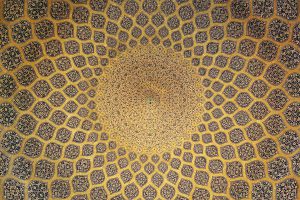A Brief Account of Early Developments in ʿIlm al-Kalām
By Yusuf Sulaiman (5th Year ʿĀlim Student, DarusSalam Seminary)
In the early years of Islām, as the Muslim Empire expanded exponentially, people accepted Islām in droves. However, many were still attached to the philosophical trends that they espoused in the religions that they had followed prior to Islām. Because of this, the Muslim ummah was exposed to external ideologies and this resulted in the spread of unorthodox beliefs. Therefore, employing a systematic approach to deconstructing false doctrines and establishing the correct Islāmic creed was imperative. This science became known as “ʿIlm al-Kalām.” To understand the development of this field, the rise of sectarian polemics must be analyzed.
Schisms, as Shaykh Muḥammad Zāhid al-Kawtharī suggested, originated from political disputes, which evolved into theological dissensions. ʿAlī’s willingness to accommodate Muʿāwiyah was unpalatable to some. They asserted that compromise, in Islām, is inconceivable. This group, who were later known as the “Khawārij,” renounced ʿAlī, deeming him unfit for the Caliphate. Their dissension was based upon their political disagreement with him.
Historically, along with the Khawārij, two other groups emerged from the conflict between ʿAlī and Muʿāwiyah. Firstly, many of ʿAlī’s supporters diverged and eventually became known as the “Shīʿah.” Secondly, shortly after, the Umayyad Dynasty was established through Muʿāwiyah’s lineage. And in that process, the theological position of jabar (trans. determinism) was adopted.
Under the Umayyads, ideological changes began to take root. The Kharijites’ stances on sin and justice led them to deny the legitimacy of a sinful caliph. The emphasis on a sinless caliph then led to their first theological divergence from the Ahl al-Sunnah. They said that sins negate one’s faith; thus, a sinner is outside of Islām.
The Kharijites elected whoever was best fit to lead according to them. It may seem like an honest democratic principle; however, nothing could be further from the truth. Checks and balances were not instituted. Unchecked power was vested with their leader, so long as he remained sinless. Yet, this methodology proved fatal. No human being, other than a Prophet, is infallible. Consequently, a leader would not remain legitimate for long. Thus, no significant political gain was ever achieved. Furthermore, their violence against Muslims was disapproved of by the masses. The Kharijites remained unpopular.
The Kharijites’ emphasis on sin eventually led to doctrinal differences that defined them. Humans are accountable for their actions. One can easily see how this led them to the doctrine of free will. If man’s actions are predestined, he cannot be held accountable. Thus, the Kharijite principle of retribution for a sinful caliph is falsified. Therefore, the Kharijites naturally adopted the doctrine of free will.
On the other hand, the Umayyads were deterministic. If actions were predetermined by God, none could question their tyranny. Thus, as mentioned above, the Umayyads become known for their jabarī dogma.
Amid these political tensions between the Kharijites and the jabarī Umayyads, pockets of resistance rose up. Those who used the doctrine of free will as their impetus for political struggle became to be known as the “Qadarīs.” They were briefly successful with the heresy of Ghaylān al-Dimashqī and Yazīd III. However, this trend ended abruptly after various military defeats. Many returned to the Sunni majority. However, Allāh willed that this would not be the end of the infamous theological dispute. The doctrine of free would become a core tenet of Mutazilite theology.
Throughout the Umayyad autocracy, ʿAlī’s supporters took a different approach. They claimed that tyranny would end when Ahl al-Bayt assumed power. This political blueprint goes back to ʿAbd Allāh b. Sabaʾ’s heresy. Again, the reason for this dissension was political nonconcurrence. However, after Ḥusayn was killed at Karbalah, politics gave rise to erroneous doctrines, which caught on with the masses. Thus, the Shiites, as a distinct sect with their own doctrines, emerged with the help of Hishām b. al-Ḥakam.
Meanwhile, the general population were perplexed. The Kharijites had renounced ʿUthmān, something which the Shiites also had a fair share in. Then, the Umayyads vindicated ʿUthmān of any fault. As for ʿAlī, the Shiites revered him while the Kharijites and the Umayyads both accused him of crimes.
Thus, many Muslims adhered to the principle of irjāʾ (trans. deferment of judgment) regarding the Companions. They also believed that a sinful Muslim is not deemed an apostate. Faith is enough to remain Muslim, and a lack of ʿamal (trans. righteous actions) would not nullify one’s islām. This was also the tenet of the Ḥanafīs, which later became a principle of the Māturīdīs. However, this doctrine took an unprecedented twist with Jahm b. Ṣafwān’s heresy (d. 128).
Jahm viewed faith as a mere internalized acceptance, without any external expression. Furthermore, he believed in absolute predestination. He said that a Muslim can suffice with just belief and not be accountable for any actions. Those who followed these tenets became known as the “Murjiʾah.”
Here, it is important to note that there are two denotations of the word irjāʾ in our Islāmic literature. Firstly, there is Sunni irjāʾ, which is a position that deems that one’s īmān is valid and separate from deeds. Secondly, there is heretical irjāʾ, which is the claim that deeds are not necessary at all. Adherents of the second category were known as the “Murjiʾah.”
As time passed into the ʿAbbāsid era, works from many other languages were translated into Arabic. The mesh with Hellenistic thought gave rise to scholastic theology (ar. ʿilm al-kalām). Many of those individuals who engaged in this were the early Murjites. Ḍirār b. ʿAmr (d. 184) was one of them. He may be considered Sunni, but he was significantly influenced by Hellenistic philosophy. Therefore, he introduced unorthodox tenets, such as manzilah bayn al-manzilatayn and rejecting the barzakh.
Thereafter, Bishr al-Mārisī, who was an advisor to the ʿAbbāsid caliph al-Maʾmūn (d. 218), introduced ideas such as the created nature of the Qurʾān. Soon after, Bishr’s prominent student, Husayn al-Najjār, elaborated on his predecessor’s beliefs. Ultimately, these three played a significant role in the formulation of a new school of thought, the Mutazilites.
Denying predestination was the hallmark of Mutazilite thought. In this way, it was a continuation of Qadarism. However, contrary to Qadarism, this was not just an idea, but a whole school of thought that overemphasized the epistemic value of rationality.
Wāṣil b. ʿAṭāʾ (d. 130) is believed to be its founder. Abū al-Hudhayl (d. 226) succeeded him and introduced the Mutazilite’s five well-known principles. The first two principles, tawḥīd and ʿadl, became analogous with their sect. The Mutazilites’ emphasis on tawḥīd led them to deny Allāh’s ṣifāt completely. Ultimately, this gave rise to the infamous debate on the created nature of the Qurʾān. As for ʿadl, they took it to an extreme. They said that God’s most important quality is justice.
Mutazilism peaked when al-Maʾmūn adopted it as the official state doctrine. His successor, Muʿtaṣim (d. 227), enforced it with an iron fist and punished anyone who defied it. Amid this perilous situation, Aḥmad b. Ḥanbal (d. 241) stood as Ahl al-Sunnah’s champion.
The Ḥanbalites who came after, perhaps as a counterreaction to the Mutazilites, over-established Allāh’s ṣifāt. Furthermore, they limited their usage of reason and stuck mostly to literalist explanations. Aḥmad himself was not fond of the kalām-orientated methodology that was employed by the Mutazilites. However, later day Ḥanbalites ended up contributing significantly to the discourse. The last piece of the puzzle for Sunni kalām was placed down by Abū al-Ḥasan al-Ashʿarī (d. 936). Advocating Ḥanbalī doctrines but using Hellenistic argumentation like the Mutazilites, he dismantled the Mutazilite creed.
On the other side of the Islāmic World, Abū Manṣūr al-Māturīdī (d. 944) coincidently concurred with al-Ashʿarī on many issues. However, contrary to the Ḥanbalī and Ashʿarī approach, Māturīdī approved of a more rational view in contentious issues, such as God’s attributes. Ultimately, the Ashʿarīs became synonymous with the Shāfiʿiyyah and the Mālikiyyah. The Ḥanafiyyah adopted the Māturīdī system, while the Ḥanbalites continued in their literalist approach, eventually becoming known as the Atharīs.
References
al-Lakhnawī, ʿAbd al-Ḥayy b. Muḥammad. al-Rafʿ wa al-Takmīl fī al-Jarḥ wa al-Taʿdīl. ed.
(Ḥalab: Maktab Maṭbūʿāt al-Islāmiyyah, AH 1407).
Blankinship, Khalid. The Cambridge Companion to Classical Islamic Theology. ed.
Tim Winter (New York: Cambridge University Press, 2008).
al-Kawtharī, Muḥammad Zāhid. Muqaddimat Tabyīn Kadhib al-Muftarī. ed.
Husām al-Dīn al-Qudsī (al-Maktabah al-Azhariyyah li al-Turāth, n.d.).
Abū Manṣūr, ʿAbd al-Qāhir b. Ṭāhir. al-Farq bayn al-Firaq wa Bayān Firaq al-Nājiyah.
(Beirut: Dār al-Āfāq al-Jadīdah, 1977).


